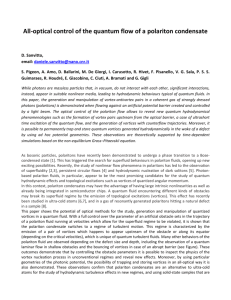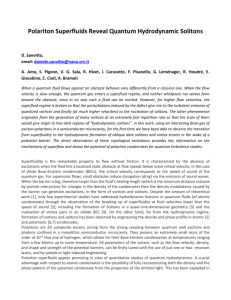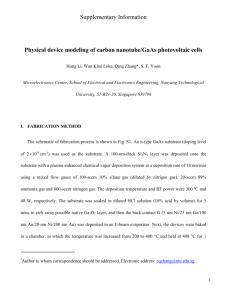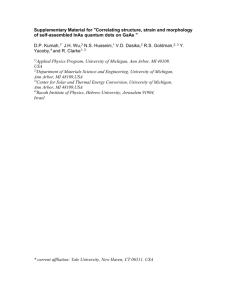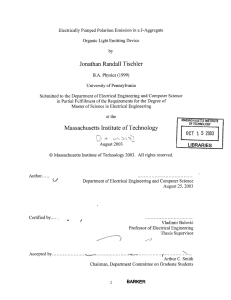Room temperature GaAs exciton-polariton light emitting diode
advertisement
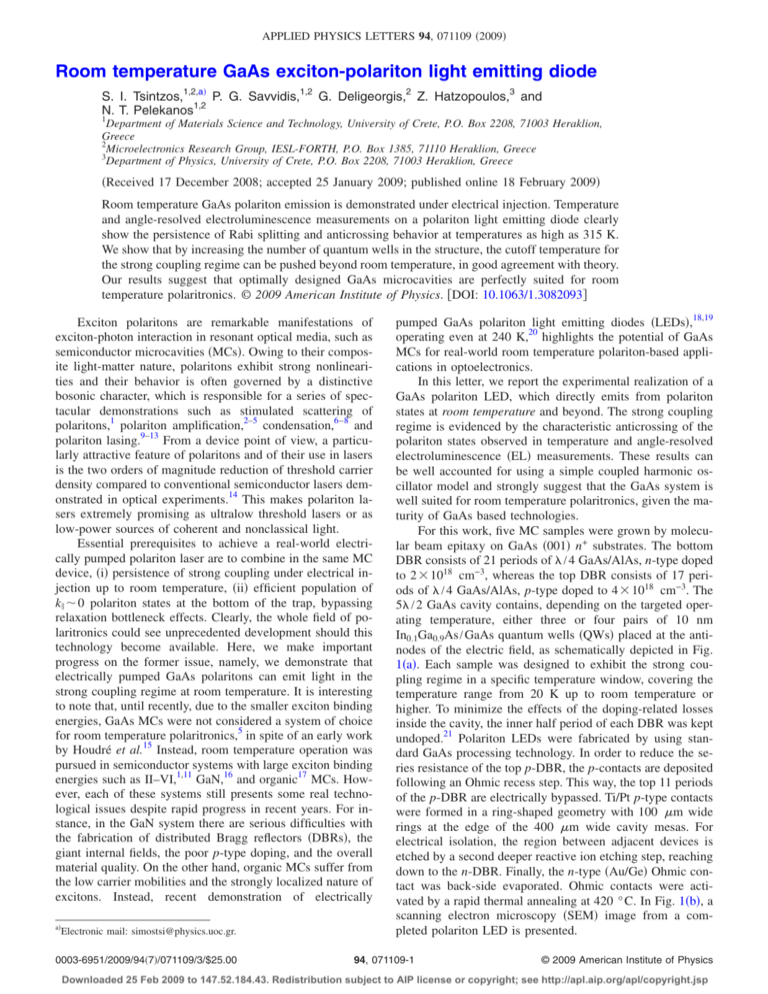
APPLIED PHYSICS LETTERS 94, 071109 共2009兲 Room temperature GaAs exciton-polariton light emitting diode S. I. Tsintzos,1,2,a兲 P. G. Savvidis,1,2 G. Deligeorgis,2 Z. Hatzopoulos,3 and N. T. Pelekanos1,2 1 Department of Materials Science and Technology, University of Crete, P.O. Box 2208, 71003 Heraklion, Greece 2 Microelectronics Research Group, IESL-FORTH, P.O. Box 1385, 71110 Heraklion, Greece 3 Department of Physics, University of Crete, P.O. Box 2208, 71003 Heraklion, Greece 共Received 17 December 2008; accepted 25 January 2009; published online 18 February 2009兲 Room temperature GaAs polariton emission is demonstrated under electrical injection. Temperature and angle-resolved electroluminescence measurements on a polariton light emitting diode clearly show the persistence of Rabi splitting and anticrossing behavior at temperatures as high as 315 K. We show that by increasing the number of quantum wells in the structure, the cutoff temperature for the strong coupling regime can be pushed beyond room temperature, in good agreement with theory. Our results suggest that optimally designed GaAs microcavities are perfectly suited for room temperature polaritronics. © 2009 American Institute of Physics. 关DOI: 10.1063/1.3082093兴 Exciton polaritons are remarkable manifestations of exciton-photon interaction in resonant optical media, such as semiconductor microcavities 共MCs兲. Owing to their composite light-matter nature, polaritons exhibit strong nonlinearities and their behavior is often governed by a distinctive bosonic character, which is responsible for a series of spectacular demonstrations such as stimulated scattering of polaritons,1 polariton amplification,2–5 condensation,6–8 and polariton lasing.9–13 From a device point of view, a particularly attractive feature of polaritons and of their use in lasers is the two orders of magnitude reduction of threshold carrier density compared to conventional semiconductor lasers demonstrated in optical experiments.14 This makes polariton lasers extremely promising as ultralow threshold lasers or as low-power sources of coherent and nonclassical light. Essential prerequisites to achieve a real-world electrically pumped polariton laser are to combine in the same MC device, 共i兲 persistence of strong coupling under electrical injection up to room temperature, 共ii兲 efficient population of k储 ⬃ 0 polariton states at the bottom of the trap, bypassing relaxation bottleneck effects. Clearly, the whole field of polaritronics could see unprecedented development should this technology become available. Here, we make important progress on the former issue, namely, we demonstrate that electrically pumped GaAs polaritons can emit light in the strong coupling regime at room temperature. It is interesting to note that, until recently, due to the smaller exciton binding energies, GaAs MCs were not considered a system of choice for room temperature polaritronics,5 in spite of an early work by Houdré et al.15 Instead, room temperature operation was pursued in semiconductor systems with large exciton binding energies such as II–VI,1,11 GaN,16 and organic17 MCs. However, each of these systems still presents some real technological issues despite rapid progress in recent years. For instance, in the GaN system there are serious difficulties with the fabrication of distributed Bragg reflectors 共DBRs兲, the giant internal fields, the poor p-type doping, and the overall material quality. On the other hand, organic MCs suffer from the low carrier mobilities and the strongly localized nature of excitons. Instead, recent demonstration of electrically a兲 Electronic mail: simostsi@physics.uoc.gr. 0003-6951/2009/94共7兲/071109/3/$25.00 pumped GaAs polariton light emitting diodes 共LEDs兲,18,19 operating even at 240 K,20 highlights the potential of GaAs MCs for real-world room temperature polariton-based applications in optoelectronics. In this letter, we report the experimental realization of a GaAs polariton LED, which directly emits from polariton states at room temperature and beyond. The strong coupling regime is evidenced by the characteristic anticrossing of the polariton states observed in temperature and angle-resolved electroluminescence 共EL兲 measurements. These results can be well accounted for using a simple coupled harmonic oscillator model and strongly suggest that the GaAs system is well suited for room temperature polaritronics, given the maturity of GaAs based technologies. For this work, five MC samples were grown by molecular beam epitaxy on GaAs 共001兲 n+ substrates. The bottom DBR consists of 21 periods of / 4 GaAs/AlAs, n-type doped to 2 ⫻ 1018 cm−3, whereas the top DBR consists of 17 periods of / 4 GaAs/AlAs, p-type doped to 4 ⫻ 1018 cm−3. The 5 / 2 GaAs cavity contains, depending on the targeted operating temperature, either three or four pairs of 10 nm In0.1Ga0.9As/ GaAs quantum wells 共QWs兲 placed at the antinodes of the electric field, as schematically depicted in Fig. 1共a兲. Each sample was designed to exhibit the strong coupling regime in a specific temperature window, covering the temperature range from 20 K up to room temperature or higher. To minimize the effects of the doping-related losses inside the cavity, the inner half period of each DBR was kept undoped.21 Polariton LEDs were fabricated by using standard GaAs processing technology. In order to reduce the series resistance of the top p-DBR, the p-contacts are deposited following an Ohmic recess step. This way, the top 11 periods of the p-DBR are electrically bypassed. Ti/Pt p-type contacts were formed in a ring-shaped geometry with 100 m wide rings at the edge of the 400 m wide cavity mesas. For electrical isolation, the region between adjacent devices is etched by a second deeper reactive ion etching step, reaching down to the n-DBR. Finally, the n-type 共Au/Ge兲 Ohmic contact was back-side evaporated. Ohmic contacts were activated by a rapid thermal annealing at 420 ° C. In Fig. 1共b兲, a scanning electron microscopy 共SEM兲 image from a completed polariton LED is presented. 94, 071109-1 © 2009 American Institute of Physics Downloaded 25 Feb 2009 to 147.52.184.43. Redistribution subject to AIP license or copyright; see http://apl.aip.org/apl/copyright.jsp 071109-2 Appl. Phys. Lett. 94, 071109 共2009兲 Tsintzos et al. 4.0 (a) + p DBR 3.6 3.4 3.2 3.0 I=0.8mA EL Intensity (a.u.) Electric Field Refractive Index 3.8 + n DBR 260K (a) 2.8 320K 2000 2500 3000 Position (nm) 3500 1.31 4000 (b) To study the emission properties of our MC polariton LEDs under electrical injection, we used both temperature and angular measurements to tune the excitonic and cavity modes with respect to each other, searching for the characteristic anticrossing between the two modes. Figure 2共a兲 shows EL spectra collected at zero angle for different temperatures in the range of 260–320 K from a polariton LED containing four pairs of QWs, exhibiting the characteristic anticrossing behavior.20 The energy dispersion curves of the upper and lower polaritons are shown in Fig. 2共b兲. The data points are extracted from the EL peaks in Fig. 2共a兲, while the solid lines are theoretical fits generated by applying a coupled harmonic oscillator model to our data.22 An excellent fitting of the upper and lower polariton branches is obtained demonstrating that EL at these high temperatures arises from exciton-polariton states in the strong coupling regime. The normal mode Rabi splitting is found to be 4 meV at 288 K. To test the endurance of polariton LED emission at even higher temperatures, we performed angle-resolved EL measurements on a polariton LED sample with four pairs of QWs, which was designed to exhibit strong coupling at T ⬎ 300 K. In Fig. 3共a兲, we present selected angle-resolved EL spectra obtained at T = 315 K under electrical injection of 0.52 mA 共⬃0.54 A / cm2兲, from a diode with a negative detuning of 11.5 meV at zero angle. The corresponding energy dispersion curves of the upper and lower polaritons are shown in Fig. 3共b兲, exhibiting a clear anticrossing at ⬃30° with a 4 meV Rabi splitting, thus demonstrating that the strong coupling regime persists even at 315 K. Using this value for the Rabi splitting, the upper and lower polariton dispersion curves are reproduced very well 共solid lines兲, using the coupled harmonic oscillator model mentioned above. 1.33 1.34 1.35 LP UP Exciton Cavity 1.34 1.33 1.32 (b) 260 FIG. 1. 共Color online兲 共a兲 Electric field and refractive index profile along the structure. The QWs are positioned at the maxima of the electric field to increase light matter coupling. 共b兲 SEM photo of polariton LED. 1.32 Energy (eV) Polariton energy (eV) 1500 280 300 Temperature (K) 320 FIG. 2. 共Color online兲 共a兲 EL spectra recorded from a polariton LED at zero angle for different temperatures between 260 and 320 K, with a step of 5 K. 共b兲 Polariton energy dispersion. The data points are extracted EL peaks and the solid lines are fits for the upper and lower polariton branches. In depth understanding of why GaAs polariton LEDs are capable of operating in the strong coupling regime at high temperatures can be inferred from Fig. 4, where all zerodetuning Rabi splittings measured in this work from various polariton LEDs as a function of temperature are plotted. Each data point is extracted from a set of temperature dependent EL experiments under normal collection, as is the case of Fig. 2. The data points are grouped into a set of circles corresponding to MCs with six QWs 共N = 6兲 and to a set of squares for MCs with eight QWs 共N = 8兲. Clearly, the Rabi splitting increases with the number of QWs and decreases with temperature. To account for these results, we employ a simplified model, calculating the zero-detuning Rabi splitting in the strong coupling regime using the equation22 ⍀共T兲 = 冑4V2 − 共␥ex共T兲 − ␥c兲2. The parameter V represents the coupling strength between the cavity photon mode and the exciton and is expected to be proportional to N1/2, while ␥ex and ␥c are the exciton and photon linewidths, respectively. The expression in the square root has to remain positive, which is a precondition for the strong coupling regime.22 In this model, the temperature dependence of ⍀共T兲 comes solely through the exciton linewidth, ␥ex共T兲 = ␥inh + ␥acT + ␥LO关exp共បLO / kT兲 − 1兴−1, where ␥inh is the low temperature inhomogeneous linewidth, ␥ac and ␥LO are constants representing the strength of exciton coupling with acoustic and LO phonons, respectively, and បLO is the LO phonon energy.23 To experimentally determine ␥ex, we performed transmittance measurements on a separate sample containing two InGaAs/GaAs QWs identical to those used in our MC structures. In the inset of Fig. 4, the measured exciton linewidth as a function of temperature is depicted. The solid line Downloaded 25 Feb 2009 to 147.52.184.43. Redistribution subject to AIP license or copyright; see http://apl.aip.org/apl/copyright.jsp 071109-3 Appl. Phys. Lett. 94, 071109 共2009兲 Tsintzos et al. (a) 0 0 T=315K I=0.52mA 0 EL Intensity (a.u) 10 0 20 0 32.5 0 40 1.30 1.34 Energy Dispersion (eV) 0 27.5 1.31 1.32 0 50 1.33 Energy (eV) 1.34 (b) UP LP Exciton Cavity 1.33 The support by the PENED national projects under Project Nos. 03⌭∆841 and 03⌭∆816 is acknowledged. 1.32 1 1.31 T=315K I=0.52mA -60 -40 -20 0 20 Angle (Degrees) 40 60 FIG. 3. 共Color online兲 共a兲 Selected EL spectra at various angles for 0.52 mA at 315 K. 共b兲 Polariton energy dispersion curves vs collection angle. The circular and square points are extracted EL peaks while the solid lines are theoretical fittings. N=12 8 N=8 N=6 6 10 Linewidth (meV) Rabi splitting (meV) running through the experimental points was obtained by fitting the equation for ␥ex共T兲 to our results, using ␥ac = 4.4 eV/ K and ␥LO = 15.2 meV. It should be noted that these values are in excellent agreement with those given by Gammon et al.23 for similar InGaAs/GaAs QWs. Using these values for ␥ex共T兲 and taking ␥c = 1 meV, directly measured in off-resonance zero-collection angle conditions, we fit both sets of data points by applying the equation for ⍀共T兲 and using V共N兲 as the only adjustable parameters. The solid lines running through the data points are best fits obtained for 4 2 8 6 4 2 0 0 100 200 300 Temperature (K) 0 V共6兲 = 3.13 meV and V共8兲 = 3.63 meV, which scale according to V共N兲 ⬃ N1/2 as expected. As we can see from Fig. 4, our model describes quite well the temperature behavior of the experimental Rabi splittings and confirms the ability of polaritonic emission from a GaAs system at room temperature. Another important point of Fig. 4 is that by increasing the number of the QWs to N = 12, the operating temperature of the polariton LED can be extended up to 340 K. To summarize, in this letter we report a clear demonstration of a GaAs polariton LED operating at room temperature. The strong coupling regime at these elevated temperatures is revealed by the characteristic anticrossing between the two polariton branches observed in temperature and angle resolved EL experiments. These findings are important because they open the way toward practical polariton emitters, based on the well established GaAs technology. 0 50 100 150 200 250 300 350 Temperature (K) FIG. 4. 共Color online兲 Comparison of theoretical and experimental zerodetuning Rabi splitting as a function of temperature. The circular points refer to MCs with six QWs, while the squares to MCs with eight QWs. Solid lines are theoretical curves for 6, 8, and 12 QWs. The inset shows the temperature dependence of the exciton full width at half maximum linewidth extracted from transmission measurements. L. S. Dang, D. Heger, R. André, F. Bœuf, and R. Romestain, Phys. Rev. Lett. 81, 3920 共1998兲. 2 P. G. Savvidis, J. J. Baumberg, R. M. Stevenson, M. S. Skolnick, D. M. Whittaker, and J. S. Roberts, Phys. Rev. Lett. 84, 1547 共2000兲. 3 C. Ciuti, P. Schwendimann, B. Deveaud, and A. Quattropani, Phys. Rev. B 62, R4825 共2000兲. 4 C. Ciuti, P. Schwendimann, and A. Quattropani, Phys. Rev. B 63, 041303 共2001兲. 5 M. Saba, C. Ciuti, J. Bloch, V. Thierry-Mieg, R. André, L. S. Dang, S. Kundermann, A. Mura, G. Bongiovanni, J. L. Staehli, and B. Deveaud, Nature 共London兲 414, 731 共2001兲. 6 J. J. Baumberg, P. G. Savvidis, R. M. Stevenson, A. I. Tartakovskii, M. S. Skolnick, D. M. Whittaker, and J. S. Roberts, Phys. Rev. B 62, R16247 共2000兲. 7 R. M. Stevenson, V. N. Astratov, M. S. Skolnick, D. M. Whittaker, M. Emam-Ismail, A. I. Tartakovskii, P. G. Savvidis, J. J. Baumberg, and J. S. Roberts, Phys. Rev. Lett. 85, 3680 共2000兲. 8 C. Diederichs, J. Tignon, G. Dasbach, C. Ciuti, A. Lemaitre, J. Bloch, Ph. Roussignol, and C. Delalande, Nature 共London兲 440, 904 共2006兲. 9 D. Porras, C. Ciuti, J. J. Baumberg, and C. Tejedor, Phys. Rev. B 66, 085304 共2002兲. 10 G. Malpuech, A. Di Carlo, and A. Kavokin, Appl. Phys. Lett. 81, 412 共2002兲. 11 J. Kasprzak, M. Richard, S. Kundermann, A. Baas, P. Jeambrun, J. M. J. Keeling, F. M. Marchetti, M. H. Szymanska, R. André, J. L. Staehli, V. Savona, P. B. Littlewood, B. Deveaud, and L. S. Dang, Nature 共London兲 443, 409 共2006兲. 12 H. Deng, D. Press, S. Götzinger, G. S. Solomon, R. Hey, K. H. Ploog, and Y. Yamamoto, Phys. Rev. Lett. 97, 146402 共2006兲. 13 L. Butov, Nature 共London兲 447, 540 共2007兲. 14 H. Deng, G. Weihs, D. Snoke, J. Bloch, and Y. Yamamoto, Proc. Natl. Acad. Sci. U.S.A. 100, 15318 共2003兲. 15 R. Houdré, R. P. Stanley, U. Oesterle, M. Ilegems, and C. Weisbuch, Phys. Rev. B 49, 16761 共1994兲. 16 S. Christopoulos, G. Baldassarri Höger von Högersthal, A. J. D. Grundy, P. G. Lagoudakis, A. V. Kavokin, J. J. Baumberg, G. Christmann, R. Butté, E. Feltin, J. F. Carlin, and N. Grandjean, Phys. Rev. Lett. 98, 126405 共2007兲. 17 J. R. Tischler, M. S. Bradley, V. Bulovic, J. H. Song, and A. Nurmikko, Phys. Rev. Lett. 95, 036401 共2005兲. 18 D. Bajoni, E. Semenova, A. Lemaitre, S. Bouchoule, E. Wertz, P. Senellart, and J. Bloch, Phys. Rev. B 77, 113303 共2008兲. 19 A. A. Khalifa, A. P. D. Love, D. N. Krizhanovskii, M. S. Skolnick, and J. S. Roberts, Appl. Phys. Lett. 92, 061107 共2008兲. 20 S. I. Tsintzos, N. T. Pelekanos, G. Konstantinidis, Z. Hatzopoulos, and P. G. Savvidis, Nature 共London兲 453, 372 共2008兲. 21 S. I. Tsintzos, P. G. Savvidis, G. Konstantinidis, Z. Hatzopoulos, and N. T. Pelekanos, Phys. Status Solidi 5, 共c兲, 3594 共2008兲. 22 A. V. Kavokin, J. J. Baumberg, G. Malpuech, and F. P. Laussy, Microcavities 共Oxford University Press, New York, 2007兲. 23 D. Gammon, S. Rudin, T. L. Reinecke, D. S. Katzer, and C. S. Kyono, Phys. Rev. B 51, 16785 共1995兲. Downloaded 25 Feb 2009 to 147.52.184.43. Redistribution subject to AIP license or copyright; see http://apl.aip.org/apl/copyright.jsp
